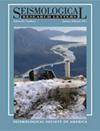A High-Resolution Site Amplification Map for Wellington, New Zealand
IF 3.2
3区 地球科学
Q2 GEOCHEMISTRY & GEOPHYSICS
引用次数: 0
Abstract
Although earthquake site effects play a crucial role in the evaluation of local seismic hazard and associated risk, their quantification over the frequency range of interest for engineering applications still remains challenging. Mapping the local amplification at high resolution is difficult even in seismically active cities such as Wellington, New Zealand. Employing traditional methods to map amplification, such as the standard spectral ratio (SSR), is realistic only with sufficient density of strong-motion stations (SMS) across the city and the presence of a suitable rock reference station. Recently, hybrid standard spectral ratio methodologies (SSRh) have been proposed to fill in the gaps and provide estimates at much finer spatial resolution. SSRh combines traditional SSR, calculated on earthquake data between a soil reference and a rock station, with SSR computed from simultaneous ambient vibration recordings (SSRn) at a temporary location and the soil reference site within the sedimentary basin. In the last decade, over 450 single-station ambient noise measurements were undertaken across Wellington, and no collocated soil reference station is available, making the SSRh method as it stands impossible to apply. To overcome this limitation, we propose an adaptation of SSRh to capture the same basin response between a soil site and soil reference station as in the case of the synchronous ambient vibration data. We employ an additional interim step that uses the traditional SSRn between each of the soil sites and a rock reference broadband station recording synchronous long-term ambient vibration. The resulting empirical amplification model using the SSRh adaptation is in good agreement with the available SSR at SMS. Amplification factors up to 10 are present along the Centreport area, where significant damage was observed during the Mw 7.8 Kaikōura earthquake. By employing the adjusted SSRh methodology, we were able to develop a first-level high-resolution empirical site amplification model for Wellington. The approach provides an attractive solution for the evaluation of site effects across regions where a significant number of unsynchronized ambient vibration measurements are available.新西兰惠灵顿高分辨率遗址放大图
尽管地震场地效应在评估当地地震灾害和相关风险方面发挥着至关重要的作用,但在工程应用所关注的频率范围内对其进行量化仍然具有挑战性。即使是在新西兰惠灵顿这样地震活跃的城市,也很难绘制出高分辨率的局部放大图。采用标准频谱比(SSR)等传统方法绘制扩增图,只有在全市强震动台站(SMS)密度足够大且有合适的岩石基准台站的情况下才可行。最近,有人提出了混合标准谱比方法(SSRh),以填补空白,提供更精细的空间分辨率估算。SSRh 将根据土壤基准站和岩石站之间的地震数据计算的传统 SSR 与根据沉积盆地内临时地点和土壤基准站的同步环境振动记录(SSRn)计算的 SSR 结合在一起。在过去的十年中,惠灵顿全境共进行了 450 多次单站环境噪声测量,但却没有可用于同一地点的土壤基准站,因此目前的 SSRh 方法无法应用。为了克服这一局限性,我们建议对 SSRh 进行调整,以捕捉土壤站点和土壤参考站之间的盆地响应,就像同步环境振动数据一样。我们采用了一个额外的临时步骤,在每个土壤站点和记录长期同步环境振动的岩石参考宽带站之间使用传统的 SSRn。使用 SSRh 适配得出的经验放大模型与 SMS 现有的 SSR 非常吻合。中心港地区沿线的放大系数高达 10,在 7.8 级 Kaikōura 地震中,该地区受到严重破坏。通过采用调整后的 SSRh 方法,我们能够为惠灵顿开发出第一级高分辨率经验站点放大模型。该方法为在有大量非同步环境振动测量数据的地区评估场地效应提供了一个极具吸引力的解决方案。
本文章由计算机程序翻译,如有差异,请以英文原文为准。
求助全文
约1分钟内获得全文
求助全文
来源期刊

Seismological Research Letters
地学-地球化学与地球物理
CiteScore
6.60
自引率
12.10%
发文量
239
审稿时长
3 months
期刊介绍:
Information not localized
 求助内容:
求助内容: 应助结果提醒方式:
应助结果提醒方式:


